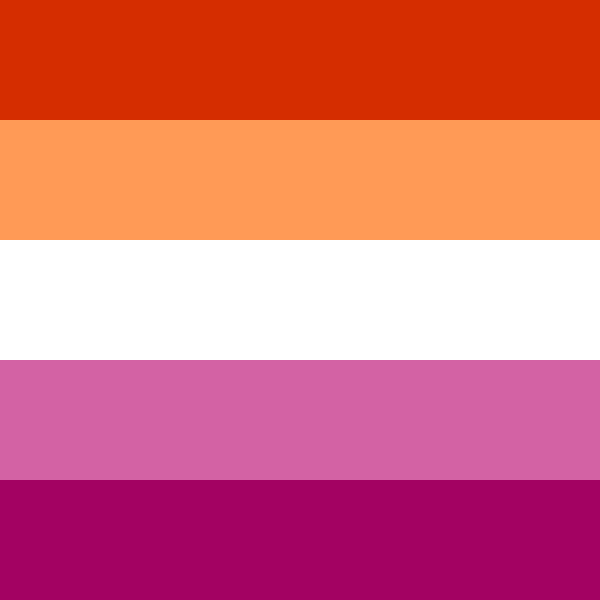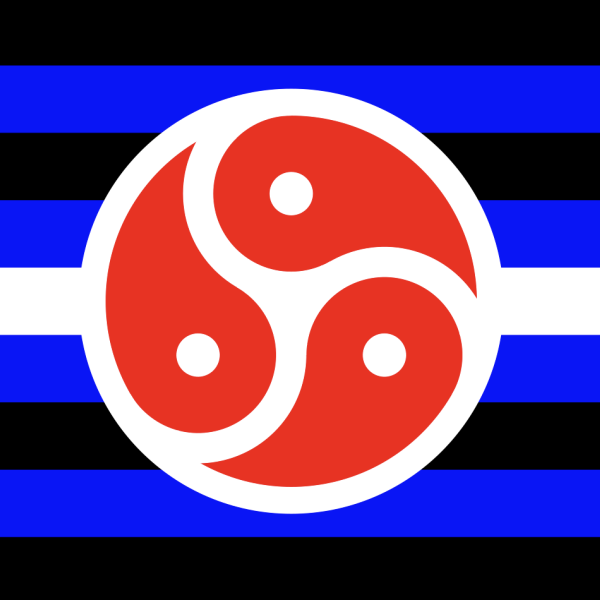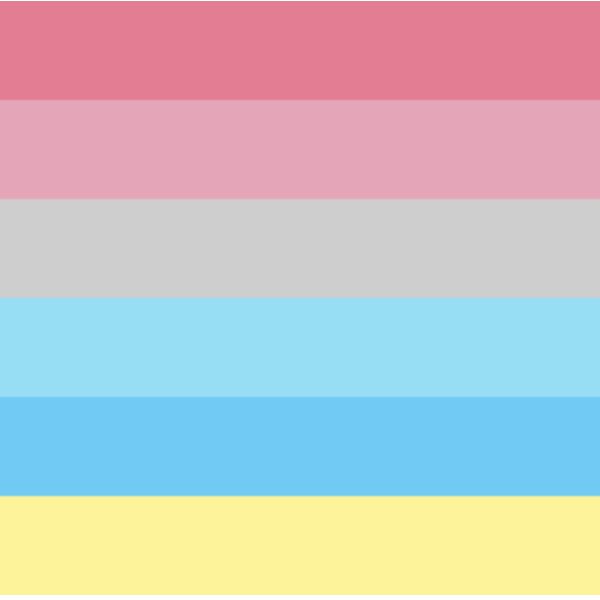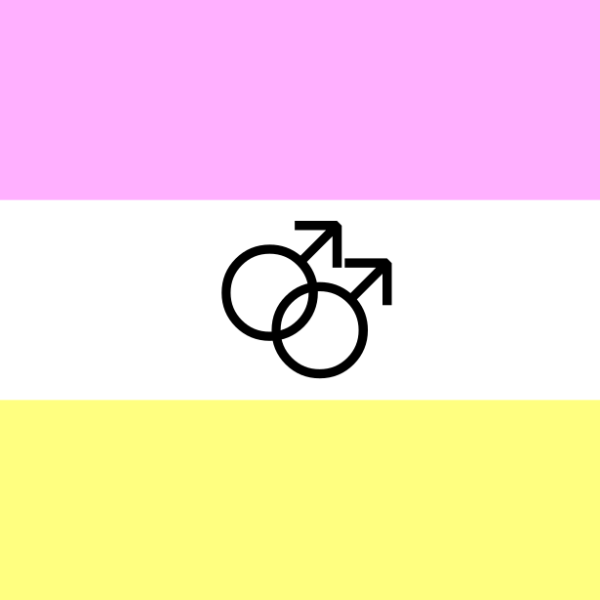Pride Flag Guide

Original Pride Flag
Gilbert Baker created the original pride flag in 1978. Baker was urged by Harvey Milk to create a symbol for the LGBT community and he chose a flag, which he saw as the most powerful symbol of pride. Baker saw the rainbow as a natural flag from the sky, so he adopted eight colors for the stripes, each with its own meaning: hot pink for sex, red for life, orange for healing, yellow for sunlight, green for nature, turquoise for art, indigo for harmony, and violet for spirit.

Rainbow Pride Flag
The six-striped Rainbow Pride flag is often used to symbolize the entire LGBTQ+ community. Though it was based on Gilbert Baker’s original eight-striped rainbow flag, the pink and turquoise from the original design were excluded for ease of production.

Philadelphia Pride Flag
The Philadelphia flag was designed in 2017, adding black and brown stripes to the six-striped rainbow flag in order to give representation to queer and trans BIPOC. The city of Philadelphia, Pennsylvania officially adopted the new Pride flag in 2017, giving this design its name.

Queer People of Color Flag
This version of the flag, created in recent years, is one design out of many that represent solidarity with the Black Lives Matter movement and the intersection of the queer and BIPOC (Black, Indigenous, and People of Color) communities. This design also pays tribute to the queer and trans people of color who began the modern LGBTQ+ liberation movement.

Bisexual Pride Flag
Bisexuality is an orientation defined as sexual, emotional, or romantic attraction to people of the same and other genders, or towards people regardless of their gender. The Bisexual Pride Flag was created by activist Michael Page. Each of the colors symbolize some kind of attraction: same-sex or same-gender attraction (magenta), attraction to other sexes and genders (blue), and attraction to both same and other sexes genders (purple).

Pansexual Pride Flag
Pansexuality is an orientation with the potential for emotional, romantic or sexual attraction to people of any gender. The Pansexual Pride flag was designed in 2010. The original creator who is currently unknown. The colors symbolize attraction to women (pink), attraction to men (blue), and attraction to nonbinary folks.

Polysexual Pride Flag
Polysexuality describes those who have romantic, sexual, or affectional desire for more than one gender. The Polysexual Pride flag was created on Tumblr in 2012. The stripes’ symbolic meaning are similar to the Pansexual Pride flag, but with green replacing yellow to differentiate them.

Asexual Pride Flag
Asexuality describes a spectrum of sexual orientations in which people do not experience sexual attraction, experience sexual attraction only situationally, or do not desire partnered sexual activity. The Asexual Pride flag was created in 2010 to bring awareness to the asexual community. The colors represent asexuality as a whole (black), gray asexuality and demisexuality (grey), sexuality (white), and community (purple).

Lesbian Pride Flag
“Lesbian” describes women whose primary attraction is toward women. Some nonbinary people may also identify as lesbians due to a connection to womanhood/the lesbian community and a primary attraction to women. A lesbian pride flag was designed in 2010 featuring a red lip mark in the corner, meant to represent lipstick lesbians. After the designer was accused of transphobia, biphobia, and racism, an updated flag was released in 2018. The colors represent gender non-conformity (dark orange), independence (middle orange), community (light orange), unique relationships to womanhood (white), serenity and peace (light pink), love and sex (middle pink), and femininity (dark pink).

Intersex Pride Flag
Intersex is an umbrella term that describes a wide range of natural physical variations that do not fit into conventional definitions of male or female. Intersex variations include variations in chromosomes, hormone balance, and external and internal characteristics. The Intersex Pride flag was created in 2013 by Morgan Carpenter as an image people could use to represent intersex people without depending upon misconceptions or stereotypes. The purple circle symbolizes wholeness, completeness, intersex people’s potentialities, and their right to make their own decisions about their bodies.

Transgender Pride Flag
Transgender is an identity and umbrella term describing people whose gender identity is different from cultural expectations based on the sex they were assigned at birth. The Transgender Pride flag was designed by Monica Helms in 2000. The flag consists of five horizontal stripes: Two blue stripes representing the traditional color for baby boys, two pink stripes representing the traditional color for baby girls, and a white stripe for people who are transitioning, nonbinary, and agender. The symmetrical design of the flag means that it is viewed correctly regardless of the direction it’s flown, symbolizing all of the people trying to find what “correctness” means for themselves.

Genderqueer Pride Flag
Genderqueer is a gender identity in which people reject notions of static categories of gender, embracing a fluidity of gender identity. People who identify as genderqueer may see themselves as being both men and women, as neither men nor women, or as falling completely outside the gender binary. This flag was created by Marilyn Roxie in 2011. The lavender stripe represents androgyny as a mixture of the blue and pink, as well as queer identity and community. The white stripe represents agender and gender-neutral identities. The green stripe is the inverse of the lavender, representing nonbinary people and all who identify outside of the gender spectrum.

Agender Pride Flag
Agender is an identity in which people do not identify with any gender, existing completely outside of the gender spectrum. The Agender Pride flag was created in 2014 by Salem X. The black and white stripes represent an absence of gender, the gray represents semi-genderlessness, and the central green stripe represents nonbinary genders.

Nonbinary Pride Flag
Nonbinary describes those who do not identify on the gender binary of woman and man. Nonbinary people’s gender identity may be completely outside of the gender binary, or fall on the spectrum between man and woman. Nonbinary is often used as an umbrella term encompassing many identities, including agender, bigender, genderqueer, and genderfluid, among others. The Nonbinary Pride flag was created in 2014 by Kye Rowan, meant to represent nonbinary people who didn’t feel represented by the genderqueer flag. The colors symbolize gender outside of the gender binary (yellow), people who hold many or all gender identities (white), genders that are considered a mix of man and woman (purple), and people who are agender (black).

Polyamory Pride Flag
Polyamory describes those who are consensually engaged in or open to multiple loving relationships at the same time. Polyamory is sometimes used as an umbrella term for all forms of ethical, consensual, and loving non-monogamy. The Polyamory flag was created in 1995 by Jim Evans. The colors symbolize openness and honesty between partners (blue), love and passion (red), and solidarity with those who must hide their polyamorous relationships (black). The Pi symbol, as an irrational number with infinite decimal places, represents infinite love.

Leather Pride Flag
The Leather Pride flag was created by artist Tony DeBlase in 1989 and is a symbol for the leather community, which encompasses those who are into leather, sado-masochism, bondage, and domination. Although the flag is often often associated with the gay leather subculture, it is not an exclusively gay symbol. The colors and imagery were left up to viewer interpretation.

BDSM Flag
BDSM stands for Bondage and Discipline, Dominance and Submission, Sadism and Masochism. BDSM refers to a wide spectrum of activities and forms of interpersonal relationships that play with power or explicitly establish power structures. While not always overtly sexual in nature, the activities and relationships within a BDSM context are almost always eroticized by the participants in some fashion. The BDSM flag was inspired by the Leather Pride flag and BDSM Emblem, specifically intended to represent the concept of BDSM Rights.

Genderfluid Pride Flag
Genderfluid describes those whose gender identity changes over time. A genderfluid person can identify as any gender, or any combination of genders at any given time. The genderfluid flag is meant to encompass all gender identities. The pink stands for femininity, blue for masculinity, purple for masculinity and femininity, white for lack of gender and black for all genders.

Genderflux Pride Flag
Genderflux is a catch-all term for gender identities in which one’s gender or sense of the intensity of one’s gender changes over time. A person who is genderflux experiences a range of intensity within a gender identity. It is unknown who created the genderflux pride flag, and there are now three new versions; however, the original is the most commonly used. ark pink represents women; light pink represents demigirls (someone who identifies as both woman and agender); grey represents agender; light blue represents demiboys (someone who identifies as both man and agender); dark blue represents men; and yellow represents non-binary genders.

Ally Flag
The Ally Pride Flag was designed sometime in the late 2000s, and celebrates the heterosexual and cisgender people who are allies of the LGBT+ community. The black and white stripes represent heterosexuality and cisgenderism, and the rainbow striped “A” stands for ally or advocate.

Two-Spirit Pride Flag
Two-spirit refers to a person who identifies as having both a masculine and a feminine spirit, and is used by some Indigenous people to describe their sexual, gender and/or spiritual identity. As an umbrella term, it may encompass same-sex attraction and a wide variety of gender variance, including people who might be described in Western culture as gay, lesbian, bisexual, transsexual, transgender, genderqueer, cross-dressers or who have multiple gender identities. Two-spirit can also include relationships that could be considered poly. The creation of the term “two-spirit” is attributed to Elder Myra Laramee, who proposed its use during the Third Annual Inter-tribal Native American, First Nations, Gay and Lesbian American Conference, held in Winnipeg in 1990. The term is a translation of the Anishinaabemowin term niizh manidoowag, two spirits.

Gay Men’s Pride Flag
This modern gay men’s pride flag is a reimagining of a previous gay men’s pride flag which featured a variety of blue tones. Deemed problematic because it employed colors that aligned with the stereotypical gender binary, the flag was redesigned. This new version of the flag is intended to include a broader spectrum of LGBTQ+ men, including transgender, intersex, and gender-nonconforming men, among others.

Omnisexual Pride Flag
Omnisexual refers to a person who can experience romantic, sexual, or affectional desires for people of all genders and sexes. This is sometimes inclusive of sexual attraction to traits or behavior beyond gender, including styles, objects or practices. The flag was designed in 2015, and the original creator never attached definitions to the colors. According to current community consensus, light pink and light blue represent the gender spectrum; pink represents attraction to femininity and women; blue represents attraction to masculinity and men; and dark purple represents attraction to people whose gender falls outside of the categories above.

Inclusive Pride Flag
Intersex columnist and media personality Valentino Vecchietti designed this new rendition of the rainbow Pride flag. The flag was officially unveiled by the advocacy group Intersex Equality Rights UK in late May, but has since spread virally on social media. It is similar in design to the Progressive Pride Flag, but includes elements from the Intersex Pride Flag: the yellow and purple circle.

Bear Pride Flag
In male gay culture, a bear is a larger, hairier man who projects an image of rugged masculinity. Bears are one of the many LGBTQ+ communities with specific codes, events, and a culture-specific identity. In 1970s San Francisco, any hairy man of whatever shape was referred to as a “bear” until the term was appropriated by larger men and other words had to be found to describe hairy other-shaped men such as otter (slim) or wolf (medium-build).

Twink Pride Flag
In male gay culture, twinks are a subset of gay males that challenge traditional masculinity. Usage of the term varies, but traits attributed to twinks can include attractiveness, having little or no body or facial hair, a slim to average build, or appearing to be younger than their chronological age.
